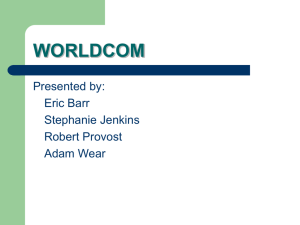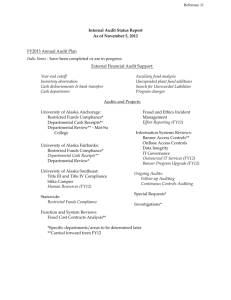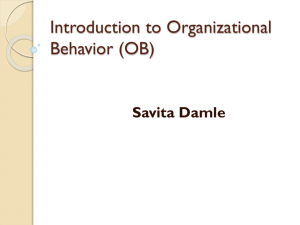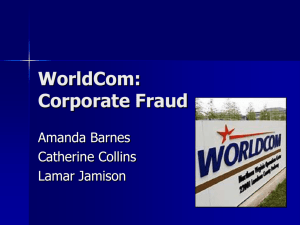Events in USA
advertisement
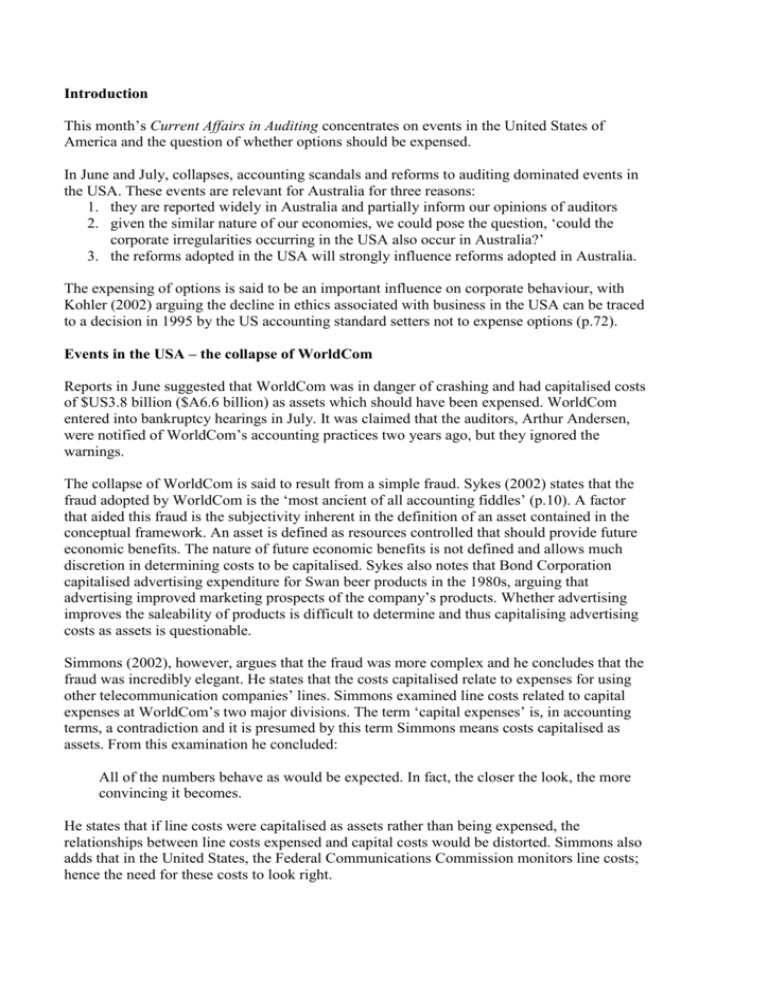
Introduction This month’s Current Affairs in Auditing concentrates on events in the United States of America and the question of whether options should be expensed. In June and July, collapses, accounting scandals and reforms to auditing dominated events in the USA. These events are relevant for Australia for three reasons: 1. they are reported widely in Australia and partially inform our opinions of auditors 2. given the similar nature of our economies, we could pose the question, ‘could the corporate irregularities occurring in the USA also occur in Australia?’ 3. the reforms adopted in the USA will strongly influence reforms adopted in Australia. The expensing of options is said to be an important influence on corporate behaviour, with Kohler (2002) arguing the decline in ethics associated with business in the USA can be traced to a decision in 1995 by the US accounting standard setters not to expense options (p.72). Events in the USA – the collapse of WorldCom Reports in June suggested that WorldCom was in danger of crashing and had capitalised costs of $US3.8 billion ($A6.6 billion) as assets which should have been expensed. WorldCom entered into bankruptcy hearings in July. It was claimed that the auditors, Arthur Andersen, were notified of WorldCom’s accounting practices two years ago, but they ignored the warnings. The collapse of WorldCom is said to result from a simple fraud. Sykes (2002) states that the fraud adopted by WorldCom is the ‘most ancient of all accounting fiddles’ (p.10). A factor that aided this fraud is the subjectivity inherent in the definition of an asset contained in the conceptual framework. An asset is defined as resources controlled that should provide future economic benefits. The nature of future economic benefits is not defined and allows much discretion in determining costs to be capitalised. Sykes also notes that Bond Corporation capitalised advertising expenditure for Swan beer products in the 1980s, arguing that advertising improved marketing prospects of the company’s products. Whether advertising improves the saleability of products is difficult to determine and thus capitalising advertising costs as assets is questionable. Simmons (2002), however, argues that the fraud was more complex and he concludes that the fraud was incredibly elegant. He states that the costs capitalised relate to expenses for using other telecommunication companies’ lines. Simmons examined line costs related to capital expenses at WorldCom’s two major divisions. The term ‘capital expenses’ is, in accounting terms, a contradiction and it is presumed by this term Simmons means costs capitalised as assets. From this examination he concluded: All of the numbers behave as would be expected. In fact, the closer the look, the more convincing it becomes. He states that if line costs were capitalised as assets rather than being expensed, the relationships between line costs expensed and capital costs would be distorted. Simmons also adds that in the United States, the Federal Communications Commission monitors line costs; hence the need for these costs to look right. This raises an interesting point about audit testing. In Australia, auditing tendering in the 1980s and early 1990s reduced audit fees. As a result, auditors changed the mix of testing, with ‘(t)he assessment of systems…an expensive process, and so auditors began to cut back their systems work and make greater use of analytical procedures’ (Higson 1997, p.200). Analytical procedures involve auditors using ratios and comparisons to examine financial statement figures to see if they are consistent with the auditor’s knowledge of the business. If they look right, this adds to the auditor’s confidence about the reliability of the figures in financial statements. The Panel of Audit Effectiveness provided evidence that this resulted in inferior audits when they stated that companies were changing their figures so that they appeared reasonable to auditors when performing their analytical procedures (para. 3.41). According to the Panel, companies were using non-standard entries to achieve this purpose. This indicates that audit-testing procedures were becoming predictable and companies adopted methods to circumvent audit-testing procedures. It is possible WorldCom changed their line figures to appear reasonable to auditors. An obvious solution is for auditors to charge appropriate fees that enable adequate evidence to be collected. To overcome the predictability of auditors’ testing methods, evidence from a variety of sources should be collected. The conclusions drawn from this variety of evidence would be more strongly based. References Higson A., 1997, ‘Developments in audit approaches: from audit efficiency to audit effectiveness, in Sherer M. and Turley S., Current Issues in Auditing, Paul Chapman Publishing, pp.198-217. Kohler Alan, 2002, ‘Share-based remuneration: the root of all evil’, The Australian Financial Review, 15-16 June, pp.10 & 72. Public Oversight Board commissioned ‘The Panel of Audit Effectiveness: Reports and Recommendations’, 31 August 2000,www.pobauditpanel.org Simmons David, 2002, ‘WorldCom’s artful dodger’, The Australian Financial Review, 10 July, p.52. Sykes Trevor, 2002, ‘Survival tips for investors in the accounting jungle’, The Australian Financial Review, 6 July, p.10.








